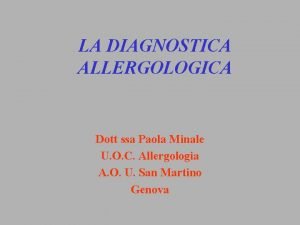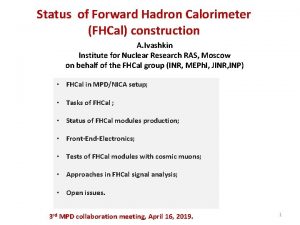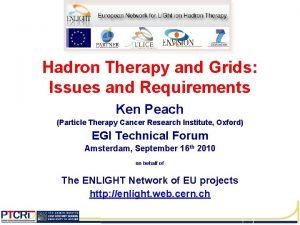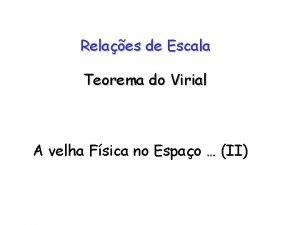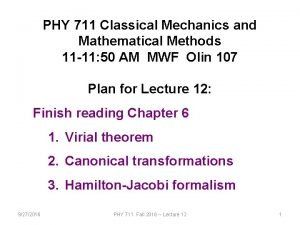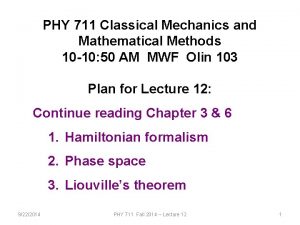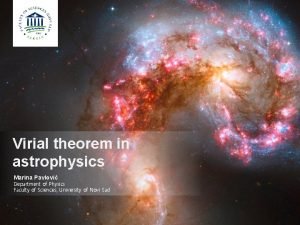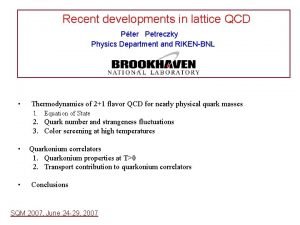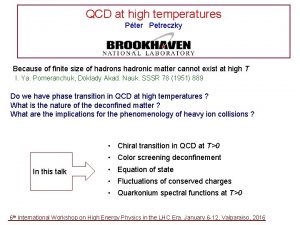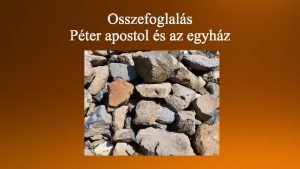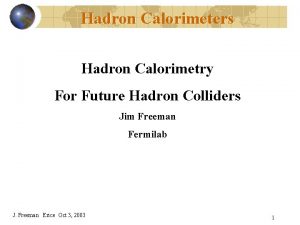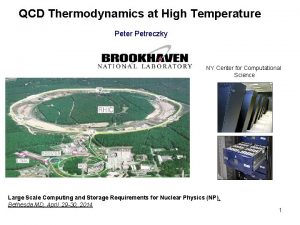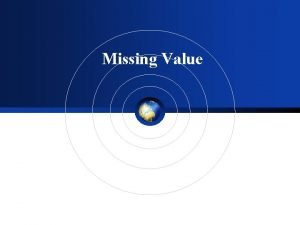Thermodynamics and Missing Hadron States Pter Petreczky Virial












- Slides: 12

Thermodynamics and Missing Hadron States Péter Petreczky • Virial expansion and hadron gas • Lattice QCD and hadron resonance gas • Strangeness fluctuations and missing strange baryons • Charm fluctuations and missing charm baryons • Conclusions APS April Meeting, April 19, 2016, Salt Lake City

Virial expansion and Hadron Resonance Gas Chiral perturbation theory is limited to pion gas. Other hadrons, resonances ? Relativistic virial expansion : compute thermodynamic quantities in terms as a gas of non-interacting particles and S – matrix Dashen, Ma, Bernstein, ‘ 69 Free gas interactions Elastic scattering only (final state = initial state) Partial wave decomposition perform the integral over the 3 -momentum invarian mass of the pair at threshold

Use experimental phase shifts to determine b 2 , Venugopalan, Prakash ‘ 92 After summing all the channels only resonance contributions survives in Interacting hadron gas = non-nteracting gas of hadrons and resonances

Equation of state in the continuum limit Equation of state has been calculated in lattice QCD for physical pion mass In the continuum limit Bazavov et al, PRD 90 (2014) 094503 Calculate thermodynamics using Hadron resonance gas (HRG) with all hadron resonances from PDG HRG agrees with the lattice for T< 145 Me. V

QCD thermodynamics at non-zero chemical potential Taylor expansion : S hadronic quark Taylor expansion coefficients give the fluctuations and correlations of conserved charges, e. g. information about carriers of the conserved charges ( hadrons or quarks ) probes of deconfinement

Deconfinement : fluctuations of conserved charges baryon number electric charge strangeness Ideal gas of massless quarks : conserved charges carried by light quarks Hot. QCD: PRD 86 (2012) 034509 BW: JHEP 1201 (2012) 138, conserved charges are carried by massive hadrons

Thermodynamics of strange hadrons Partial pressure of strange hadrons in uncorrelated hadron gas: should vanish ! • v 1 and v 2 do vanish within errors at low T • v 1 and v 2 rapidly increase above the transition region, eventually reaching non-interacting quark gas values Bazavov et al, PRL 111 (2013) 082301 No sensitivity to details of the hadron spectrum

Strange baryon resonances and problem of “missing” states The experimental knowledge of the hadron spectrum is incomplete: more excited states are expected to exists Missining states, Capstick, Isgur, PRD 34 (1986) 2809 Ω baryon spectrum in quark model Löring et al, EPJA 10 (2001) 447 Ω baryon spectrum in lattice QCD Edwards et al, PRD 87 (2013) 054506

Thermodynamics of strange hadrons and missing states Use excited strange hadrons from quark model to calculate the pressure from HRG and then contrast to lattice QCD Significant enhancement of the strange baryon pressure due to missing excited baryon states no significant effect from the “missing” strange mesons Bazavov, PRL 113 (2014) 072001 Lattice results on strangeness fluctuations baryon strangeness Correlations agree with HRG that includes the “missing” states

Missing states and freezout in heavy ion collisions Close to Tc relaxation rates become small compared to the expansion rates and the system created in heavy ion collisions freezes out The freeze-out is characterized by: (Tf, μf. B, μf. S, ) and hadron abundancies can be calculated from HRG Yields of baryons and ant-baryons: If missing states are included

Baryon-charm correlations and “missing” charm baryons Charmed baryon spectrum is poorly known Ebert et al, PRD 84 (2011) 014025 M 2 [Ge. V 2] J Use baryon-charm correlations to look for missing states Bazavov et al, PLB 737 (2014) 210

Summary • Using virial expansion and experimentally known phase shifts one can show that in certain cases thermodynamics of interacting hadron gas can be described as non-interacting gas hadrons and hadronic resonances ( HRG ) • Equation of state and certain combination of fluctuations of conserved charges can be well described by HRG • Baryon-strangeness and baryon-charm correlations can only be described if additional baryon states predicted by quark model and LQCD (missing states) are included in HRG • Including the missing strange baryon states in the statistical description lowers the freeze-out temperature of strange baryons extracted from experimentally observed yields and makes it consistent with Tc No separate freeze-out of strange and non-strange hadrons
 Dermografismo tem cura
Dermografismo tem cura Hadron calorimeter
Hadron calorimeter Hadron collider
Hadron collider Hadron collider
Hadron collider Lhc tantalizing new physics
Lhc tantalizing new physics Hadron
Hadron Teorema do virial
Teorema do virial Virial theorem in classical mechanics
Virial theorem in classical mechanics Virial theorem in classical mechanics
Virial theorem in classical mechanics Persamaan keadaan dalam
Persamaan keadaan dalam Virial theorem in astrophysics
Virial theorem in astrophysics Contoh soal persamaan virial
Contoh soal persamaan virial Contoh soal persamaan virial
Contoh soal persamaan virial
